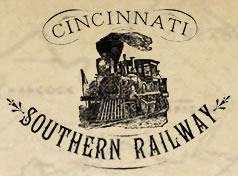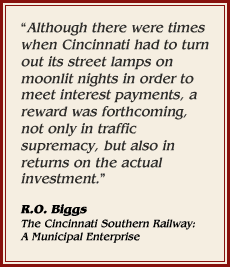1835
First public meeting held in Cincinnati to consider railway transportation between Cincinnati and the cities of the South.
1836 - July
Cincinnati sends a delegation to the Great Southwestern Railroad Convention conceived by John C. Calhoun. A Cincinnati, Louisville, Charleston line shows promise.
1837
Financial crash of 1837 derails Cincinnati, Louisville, Charleston line project.
1851
Ohio Constitution prohibits counties, cities and towns from becoming owners in any joint stock company, thereby hampering Cincinnati’s ability to construct its railway.
1859
An attempt is made at raising a $1,000,000 cash bonus from private entrepreneurs to be awarded to the Cincinnati, Lexington and East Tennessee Railroad in exchange for establishing a connection through to Knoxville, TN. The Civil War intervened, forcing the project to be abandoned.
1861-1865
General Burnside offers his plan to establish a military railroad to the South, with President Lincoln recommending its construction to Congress in December 1861. Cincinnati was considered for the railway connection and surveys were made, but other war events overshadowed the project and it too was abandoned.
1868
E.A. Ferguson puts forth his "remarkable proposition" that the City of Cincinnati itself should build and own a southern railway. His idea was endorsed in the November 25, 1868 edition of the Cincinnati Daily Enquirer and the City of Cincinnati spent $578.90 lobbying for the measure in Columbus.
1869 - May 4th
The Ferguson Bill becomes law (formally titled "An Act Relating to Cities of the First Class Having a Population Exceeding 150,000 Inhabitants").
1869 - June 4th
Cincinnati City Council adopts a resolution designating Chattanooga as the southern terminus of the Cincinnati Southern Railway.
1869 - June 26th
The City of Cincinnati votes for $10 million in bonds to build the railway with 15,435 votes for and just 1,500 against the measure. Historian accounts reported "the day was made a holiday. Nine bands of music paraded the street. The fire bells rang at six in the morning, at noon, at three in the afternoon. Various wards organized. A full vote was urged." (Charles G. Hall, Ed., The Cincinnati Southern Railway, A History, Cincinnati: McDonald Press, 1902.)
1869 - June 30th
The first board of trustees is named by the Superior Court of Cincinnati. The Court named Edward A. Ferguson, Richard M. Bishop, Miles Greenwood, William Hooper, and Philip Heidelbach. Mr. Greenwood was subsequently named the first president of the board.
1870 - January 20th
Tennessee passes legislation allowing the railway into the state (Tennessee Public Acts 291).
1870 - February 18th
Kentucky – Louisville specifically – proved more unwilling to allow the railway into its state, to the dismay of central and eastern Kentuckians. A colorful editorial in the Cynthiana Democrat that was quoted in the Cincinnati Commercial said, "The country traversed is willing and more than willing, but here comes in the mean envy of a second rate city that happens to be on our side of the river, to oppose it, like a dog in the manger… Cincinnati has as many Kentuckians, and friends of Kentuckians, among her people as has Louisville, the little snob."
1871 - February 13th
Two years after the debate began, Kentucky approved the legislation allowing the railway.
1873 - December 12th
The first contract for excavation was awarded. The $5,000 contract was for a tunnel built through King’s Mountain in Tennessee.
1875 - May
First $10 million in bonds is used before the railroad’s completion.
1876 - January
The Trustees were forced to ask the City of Cincinnati for an additional six million dollars to complete the railroad.
1876 - March 14th
The city voted 21,433 for and 9,323 against the additional six million dollars in bonds.
1877 - July 3rd
The first license was issued before the railroad’s completion to the Cincinnati Southern Railway Company, but the lease was terminated just over a year later.
1877 - July 23rd
Railroad opens to passenger traffic on the completed portion from Ludlow to Somerset.
1877 - July 23rd
The first freight traffic uses the completed portion of the railroad.
1878 - May 3rd
The Trustees found themselves asking the citizens of Cincinnati to vote for another two million dollars that they were sure would complete the road. However, public opposition to the railroad was starting to swell and the people of Cincinnati were concerned that another two million would not be enough. Though the paper wrote in support of the funding, the Cincinnati Enquirer also mocked the railroad as "our white elephant" and the measure was defeated by a razor-thin margin of 11,179 for and 11,349 opposed.
1878 - August 14th
To garner support of Cincinnati voters, bids were taken under the strict requirement that the railroad completion could not exceed two million dollars. With that promise in place, voters then supported the railway funding 16,244 to 10,424.
1879 - May 21st
A second license to operate the completed portion of the railroad was granted to the Cincinnati Railroad Company that lasted a little over two years.
1879 - December 10th
Workmen spiked the last rail in place.
1880 - February 21st
The first freight train completes the route from Cincinnati to Chattanooga.
1880 - March 8th
The first passenger train completes the 336 mile journey from Chattanooga to Cincinnati.
1880 - March 18th
Trainloads of southern dignitaries are brought to Cincinnati for the grand banquet. The banquet was held at Music Hall and was described as "the largest banquet ever spread in the United States, up to that date."
1881 - September 7th
The Cincinnati, New Orleans & Texas Pacific Railway’s (CNO&TP) bid for the Cincinnati Southern Railway won the right to a 25-year lease. With CNO&TP controlling the railroad, there was now a direct route from Cincinnati to New Orleans which became popularly known as the "Queen and Crescent Route."
1896
The first attempt to purchase the Cincinnati Southern Railway was made by the Southwestern Construction Company. The attempt was brought to the citizens of Cincinnati and failed by 338 votes, 15,493 to 15,931.
1901 - November 5th
The citizens of Cincinnati overwhelmingly approved the modification and extension of the lease 47,486 to 15,168. On the same day, they approved $2.5 million in bonds for terminal facilities by a vote of 46,658 to 14,603.
1961
The Cincinnati Southern Railway undergoes major reconstruction to modernize the railroad.
1987
The City of Cincinnati renegotiates the terms of the lease for a more favorable annual income. In accordance with a recommendation in the Smale Commission report, the City Council endorses a policy to dedicate funds generated by the Southern Railway to infrastructure projects.
The Cincinnati Southern Railroad has proven to be a great moneymaker for the city. In The Cincinnati Southern Railway: A Municipal Enterprise R.O. Biggs wrote, "Although there were times when Cincinnati had to turn out its street lamps on moonlit nights in order to meet interest payments, a reward was forthcoming, not only in traffic supremacy, but also in returns on the actual investment."

